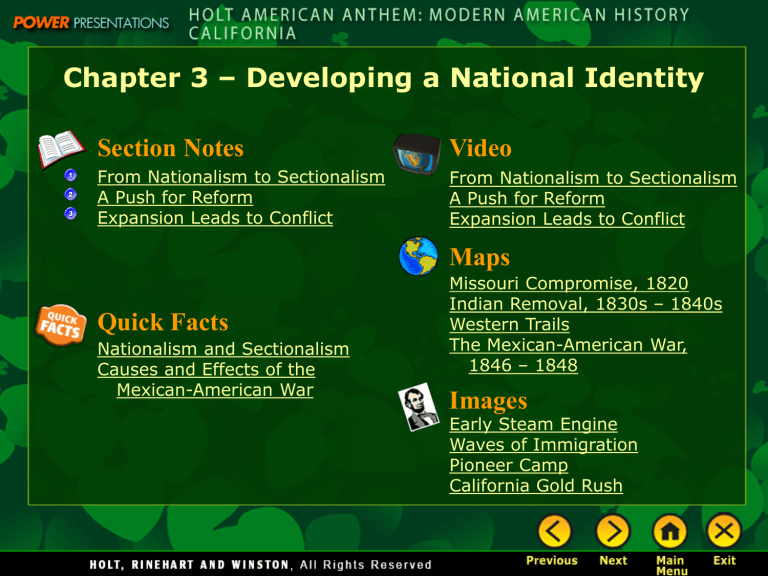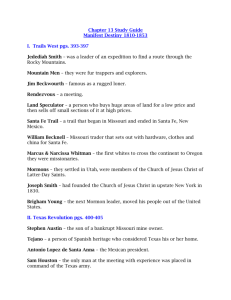Chapter 3 with Pair Share

Chapter 3 – Developing a National Identity
Section Notes
From Nationalism to Sectionalism
Quick Facts
Video
From Nationalism to Sectionalism
Maps
Images
From Nationalism to Sectionalism
11.1.3
The Main Idea
In the early 1800s, feelings of nationalism grew, although conflicts between different regions of the United States were also emerging.
Reading Focus
• What events reflected the rise of nationalism in the United States?
• What was the Age of Jackson?
• How did the Industrial Revolution affect the North?
• What was the importance of cotton in the South?
Under President James Monroe, America’s foreign and domestic policies reflected rising nationalism and the growing economy.
Foreign Policy
• The War of 1812 sparked national pride for Americans.
• Monroe’s foreign policy included
– The Adams-Onís Treaty (1819): Acquired Florida as a boundary between Louisiana and Spanish land; let Americans
– The Monroe Doctrine: Made America off-limits to European colonization; stated that America should stay out of European affairs and vice versa
– settle Oregon for 10 years
Monroe Doctrine
What are you feeling on the
Monroe Doctrine? Do you believe that America should stay out of the business of Foreign
Affairs or Vise Versa?
The Missouri Compromise
• Pride in the rapid spread of settlement fueled American nationalism, though it also caused some controversy.
• Of the 22 states existing in 1819, exactly half legally allowed slavery, most of which were Southern.
• This exact balance allowed for equal representation in the
Senate, which would be disturbed if Missouri were granted statehood as a slave state.
• The Missouri Compromise admitted two states to the union instead of one: Missouri, a slave state and Maine, a free state.
Though the Missouri Compromise kept the balance, feelings of sectionalism, or the belief that the interests of one’s own region is more important than the whole, were emerging between the North and South.
Missouri Compromise
Sectionalism
The Age of Jackson
Jackson’s Presidency
• Andrew Jackson lost his first election to John Quincy Adams, but defeated
Adams after his first term.
• Jackson supporters created a new party, the Democratic Party, and Adams supporters became known as the National Republicans.
• Jackson’s presidency is known as the “Age of Jackson.”
Native American Conflicts
•Jackson’s presidency is marked by conflict with the Native Americans, especially five major groups in the Southeast whose land settlers wanted.
•Jackson’s solution was the Indian Removal Act, which called for the relocation of Native American groups to an area west of the Mississippi River.
Native American Relocation
• The U.S. Army supervised the relocation, in which Native Americans were forced to march hundreds of miles in miserable conditions.
• So many Cherokees suffered and died that the march became known as the
Trail of Tears.
Trail of Tears Video
Was placing Indians on
Reservations inevitable? With your partner come up with a different solution to the issue of settlers moving on to Indian land.
The Industrial North
• The Industrial Revolution (mid-1700s to mid-1800s) included the birth of modern industry and the social changes that accompanied industrial growth.
• The Revolution began in the British textile industry when inventors created water-powered and steam-powered weaving machines.
• The steam engine was crucial to the British Industrial Revolution, mostly due to improvements James Watt made late in the century.
• The British made laws to prevent their knowledge of these industrial machines from spreading, but Samuel Slater violated those laws by building a textile mill in Rhode Island, launching the Industrial Revolution in America.
• By 1810 there were more than 60 textile mills in New England.
• Industrialization led to urbanization, as the percentage of the population who lived in cities doubled within 30 years.
Transportation and Communication
Advancements
Roads
By 1840 a network of roads connected most U.S. cities, promoting travel and trade.
Canals
In 1825 the Erie Canal connected the Great Lakes and Atlantic Ocean and providing a quick, economical shipping route. More than 3,000 canals were built in the Northeast over the next 15 years.
Railroads
In 1830 the first steam-powered train ran in the U.S., and by 1840, 3,000 miles of track crossed the country, increasing travel and transport.
The Telegraph
In 1840 Samuel Morse patented the revolutionary telegraph, a communication device that allowed instantaneous communications. The device was soon widely used by newspapers, railroads, and businesses.
Cotton and the South
The Cotton Revolution
• Eli Whitney’s cotton gin, which separated the seeds from the usable parts of the cotton, made large-scale cotton production possible.
• The cotton gin was simple, but had a major impact on life in the
South
– The booming textile industry in the North bought cotton to weave into cloth that was sold to Americans.
– The British Industrial
Revolution raised the demand for cotton, making
Southern cotton very valuable to grow.
Slavery Spreads
• Even with the use of the cotton gin, farming cotton required a large number of workers.
• The first cotton farms were small and didn’t use enslaved
African Americans, but wealthier farmers soon bought huge plantations and needed additional workers.
• Planters knew that the more enslaved African Americans they used, the more valuable cotton they could grow.
• Between 1810 and 1840 the number of enslaved African
Americans in the U.S. more than doubled to 2.5 million.
Cotton Gin
Differences in the North and South
• The economic differences between the industrial North and the agricultural
South led to greater differences between the two regions.
• Trade and industry led to Northern urbanization, and transportation and communication advances were used by Northern industrialists.
• The greatest difference centered around slavery, which was legal and viewed as economically vital in the South, but illegal and viewed as problematic in the North.
• Few realized that these differences would lead to the Civil War.
North
• Free states
• Favored a strong national government
• More nationalist
• Urban / Industrial
• Stronger transportation network
South
• Slave states
• Favored states’ rights
• More sectionalist
• Rural / Agricultural
• Weaker transportation network
• Dependent on slave labor
A Push for Reform
11.3.1
11.3.2
11.3.3
The Main Idea
The Reform Era led to some improvements in American society as well as the beginning of the women’s movement and the abolition movement.
Reading Focus
• How did religion spark reform in the early nineteenth century?
• How did early immigration lead to urban reform?
• What was the role of women in the Reform Era?
• What was the abolition movement?
Religion Sparks Reform
• Western New York became known as the Burned-Over District as the flames of religion took over the minds of the people. New movements included
Mormon, started by Joseph Smith
Seventh-day Adventist, started by William Miller
Shaker farms, utopian communities, Spiritualism
• Across the country, especially in the North, Americans experienced the Second Great Awakening, as people took up religion in huge numbers.
• Preachers of the Second Great Awakening were Protestant, and they did not preach adherence to church rules or obedience to a minister, but rather that hard work and dedication could bring heaven on earth.
• The Second Great Awakening’s moral focus sparked the Reform
Era, a time when Americans tried to reshape their society.
Reform in Cities and Industries
Urban Reform
• Growing cities had many immigrants living in tenements, or poorly made, crowded apartment buildings that were filthy and dark.
• In an early reform effort, local boards of health set sanitation rules in some cities, though conditions remained bad for many years.
Industrial Reform
• From 1820 to 1860 the number of American manufacturing workers soared from 5 percent to more than 30 percent, which had far– reaching social results.
• Workers were given long hours, unsafe conditions, and low wages.
• Workers began to organize into groups, demanding better working conditions, and starting the American labor movement.
• The Ten-Hour Movement caused President Jackson to declare 10hour work days for some federal workers. President Martin Van
Buren later extended the rule to others in 1840.
Women in the Reform Era
Women Reformers
• Though women could not vote, serve on juries, or run for office, they played a large role in reform movements such as prison reform, education reform, and the temperance movement.
• All reform movements were rooted in the moral changes of the Second Awakening, and this opened doors for women.
– Many women did good works
– Started Bible groups
– Started missionary societies that later became reform societies
– Focused on issues from education to urban reform
Women’s Right Movement
• The Seneca Falls Convention in 1848 was the first women’s rights convention in America.
• Two generations of women had already worked for greater rights, but women still couldn’t vote or hold public office.
• Dedicated abolitionists Lucretia
Mott and Elizabeth Cady
Stanton organized the convention.
• The Seneca Falls Declaration, held: “men and women were created equal.”
• The declaration was widely ridiculed, as were the women and few men who supported it.
Temperance Movement
Seneca Falls Convention
“All men and Women are created equal”
In your opinion, Why was the Women
Rights Movement during this time period (1840’s) not successful in bringing about real change?
Anti-Slavery Efforts in the South
• Some African Americans in the South were freemen, or African
Americans who had been emancipated.
• These men and women faced legal and social discrimination, yet still played a large role in anti-slavery activities.
• Many freemen helped enslaved people escape, and many bravely spoke out for freedom for all African Americans.
• In 1831 the deadliest slave uprising in American history took place. Nat
Turner and his accomplices killed dozens of whites before the uprising was put down by a local militia.
• Other enslaved African Americans chose to attempt escape, trying to reach the free states of the North, Canada, or Mexico.
• Over the years, a constantly changing network of escape routes developed called the Underground Railroad. Sympathetic whites and freemen provided help to escaping slaves. Harriet Tubman, who escaped slavery herself, helped many on their journey to freedom.
The Abolition Movement in the North
• The number of enslaved people trying to escape increased in the
1830s, possibly encouraged by an anti-slavery movement in the
Northern states.
• The Second Great Awakening’s focus on morality caused many
Northerners to see slavery as wrong and ungodly.
• Many joined reform societies to stop slavery
• 1833: William Lloyd
Garrison founded the American Anti-
Slavery Society.
• It was the first group to call for an immediate end to
U.S. slavery.
• In five years, had over 1,500 chapters in the North.
• Many abolitionists were women.
• Sarah and Angela
Grimké, daughters of a Southern slaveholder, were abolitionists.
• They moved to the
North to support abolition and women’s rights.
• Frederick
Douglass, who escaped slavery, was a leading abolitionist.
• He published an
1845 biography,
Narrative of the
Life of Frederick
Douglass.
Opposition to Abolition
• Though the majority of white southerners did not own enslaved people, the minority who did found abolition outrageous, as if it were an attack on their livelihood and, to some, their religion.
• Slaveholders argued that slavery was essential to cotton production, which was a powerful argument even in the
North, because cotton accounted for 55% of American exports.
• In fact, most Northerners supported slavery as well, since freedom for slaves meant more competition for jobs.
• Still, the pressure to abolish slavery in the U.S. was undeniable.
Expansion Leads to Conflict
The Main Idea
As the United States pushed westward, conflict erupted between Texas and Mexico.
8.8.2
8.8.6
Reading Focus
• How did the idea of manifest destiny influence Americans’ western migration?
• How did Texas achieve independence from Mexico?
• What were the causes and effects of the Mexican-American
War?
Manifest Destiny Encourages Settlers
• Hundreds of thousands of Americans migrated West in the
1840s and 1850s, settling in different places, yet sharing the dream of new opportunity.
• Some Americans believed in Manifest Destiny, which meant they thought it was America’s God-given right to settle western lands.
• Several major western trails were well-established by 1850:
The Santa Fe Trail led from
Independence,
Missouri to Santa
Fe, New Mexico.
The Oregon Trail was the longest, most famous trail leading from
Independence
Missouri to the
Willamette Valley in Oregon.
The Mormon Trail was the path that
Joseph Smith’s persecuted
Mormons followed in search of religious freedom in the West.
How does Manifest Destiny lead to continued conflict with the Native
Americans?
The Gold Rush
• In 1848 a carpenter discovered gold at John Sutter’s sawmill in northern California.
• News of gold spread and many migrated to California; this mass migration of miners, and businesspeople who made money from miners, was called the Gold Rush.
• The 80,000 migrants called forty-niners left for California in 1849; this population boom enabled California’s statehood a year later.
• In the 1850s the dream of finding gold brought people from all over the world, but mostly from America, to California. They came on the California Trail, on ships, and on mule trains.
• In California, miners moved into camps and businesspeople moved into booming cities like San Francisco, Sacramento, and
Stockton.
Gold Rush
Gold Rush Video
The Texas Revolution
The Texas Revolution
• In order to settle in Texas,
Americans had to agree to specific Mexican demands.
– Surrender American citizenship
– Swear allegiance to Mexico
– Adopt Roman Catholicism
– Hold the land for seven years
• The Texan settlers wanted independence from Mexico, which led to the Texas Revolution.
• Stephen F. Austin went to Mexico with the plan, but Mexican president Antonio López de
Santa Ana saw independence as a threat.
• Santa Ana suspended some of the powers of Texas, and in 1836
Texas declared its independence.
The Alamo
• The most famous battle of the
Texas Revolution took place at the Alamo, a former mission turned into a military fort.
• A furious Santa Ana personally led 6,000 soldiers to the Alamo, demanding surrender, but
Texan commander William
Travis replied with cannon fire.
• After 12 days and nights,
Mexican soldiers stormed the fort, killing its 200 defenders, including David “Davy”
Crockett.
• Soon after, Texans captured
Santa Ana in the Battle of San
Jacinto, forcing him to recognize Texas independence.
The battle’s rallying cry was
“Remember the Alamo!”
The Mexican War
• Believing that Texas was still Mexican territory, Mexico cut diplomatic relations with America after it annexed Texas.
• James K. Polk, elected as President in 1845, believed in annexation and wanted even more Mexican territory for the U.S., including New
Mexico and California.
• New Mexico and California had very few American settlers, but the
Mexican government had little presence in these regions.
• Polk sent a messenger to Mexico to purchase these territories, offering a reduction of Mexico’s debt and up to $30 million in exchange.
• No one in Mexico would meet with Polk’s messenger, John Slidell.
• Slidell, furious, suggested Mexico should be punished, and a boundary dispute soon after led America to declare war on Mexico in 1846.
• This was the beginning of the Mexican War.
The Republic of California
• The U.S. used an aggressive strategy to win the war:
– General Stephen Kearny marched west from Kansas to New Mexico and easily took control by capturing Santa Fe.
– Kearny then went west, hoping to repeat the victory in California.
• Meanwhile, a group of American rebels in Sonoma, California, defeated the Mexicans and declared California an independent republic.
– The rebels made a crude flag for their country with a picture of a bear on it, and the incident became known as the Bear Flag Revolt.
• A month later, U.S. forces arrived and took control of California.
• American forced under General Zachary Taylor captured towns in northern Mexico.
• A force under General Winfield Scott took Mexico City.
• Within months, America had captured New Mexico, California, and
Mexico’s capital, forcing Mexico to meet American demands.
Results of the Mexican War
• The 1848 Treaty of Guadalupe Hidalgo ended the Mexican War
• Under the treaty, Mexico gave up its claim to Texas, as well as to a huge tract of land that included present-day New Mexico, California, Nevada,
Arizona, Utah, Colorado, and Wyoming.
• This land was known as the Mexican Cession.
• The same year the treaty was signed, gold was discovered in California.
• In return for the territory, America paid Mexico $15 million and dropped its claim for $3 million in damages.
• In 1853 the Gadsden Purchase clarified the treaty boundary and transferred more land to the United States.
• Causes and Effects of the Mexican War included
Causes
• Annexation of Texas
• Boundary dispute between U.S. and Mexico
• Manifest destiny and expansionism
Effects
• Treaty of Guadalupe Hidalgo
• Mexican Cession
• Gadsden Purchase
• Debate that lingers to this day
Click on the window to start video
Click on the window to start video
Click on the window to start video






